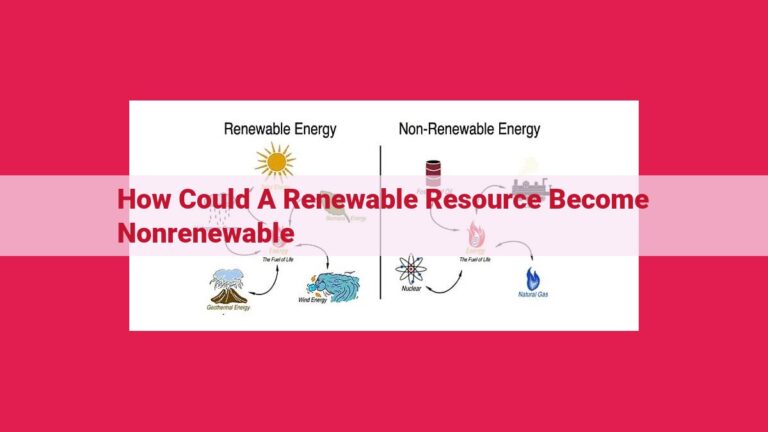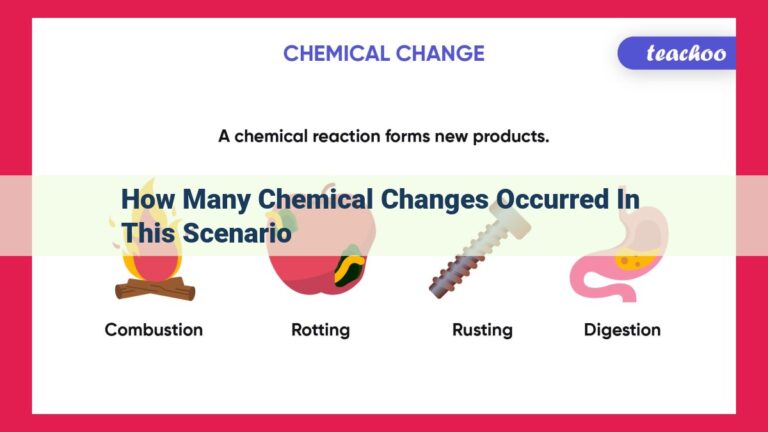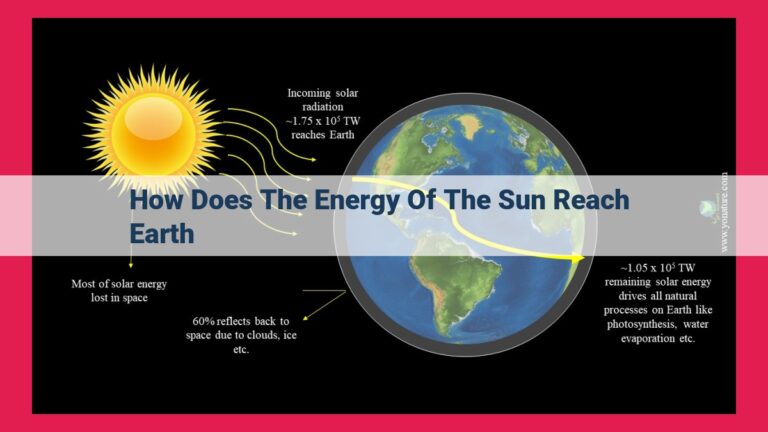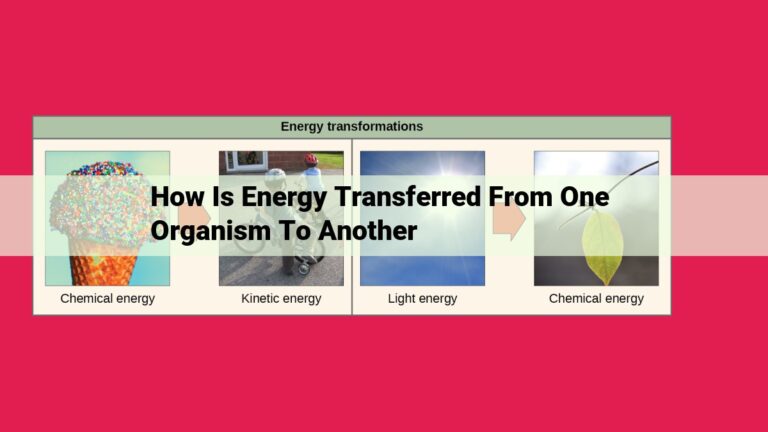Anaerobic Respiration: Energy Production In Oxygen-Depleted Environments
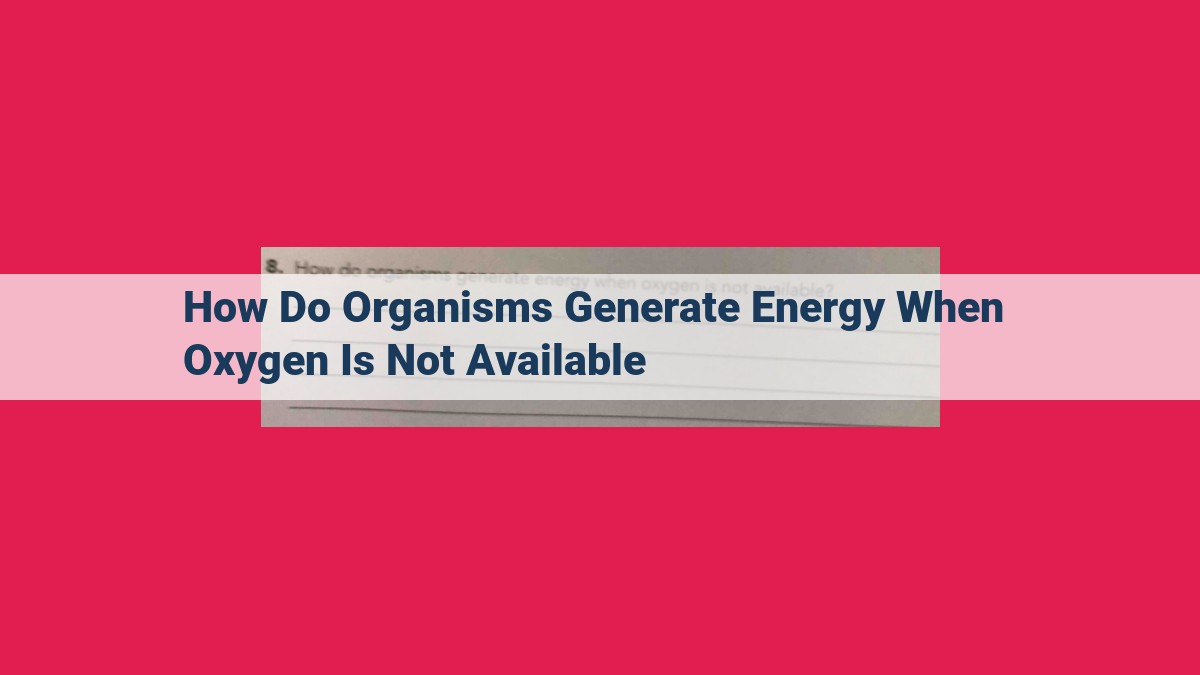
When oxygen is scarce, organisms employ anaerobic respiration to generate energy. This process, distinct from cellular respiration, relies on fermentation, a chemical pathway that breaks down organic molecules into simpler ones, releasing energy. Anaerobic organisms use substrate-level phosphorylation to produce ATP, an energy molecule. Without the electron transport chain, they rely solely on substrate-level phosphorylation for energy production. Anaerobic respiration is crucial for organisms in oxygen-deprived environments, allowing them to survive and adapt to challenging conditions.
Energy Production in Living Organisms
The Powerhouse of Life: Energy Generation in Living Beings
From the smallest bacteria to the mighty blue whale, all living organisms share a fundamental need: energy. This vital force fuels every aspect of life, from cellular processes to complex behaviors. The generation of energy in living beings is a fascinating and intricate process that has evolved over billions of years.
Cellular Respiration: The Role of Oxygen
The primary mode of energy production in most organisms is cellular respiration, a process that utilizes oxygen to break down glucose, a type of sugar. During this reaction, oxygen acts as the final electron acceptor, facilitating the transfer of electrons through an electron transport chain. This chain of proteins generates a proton gradient that drives the synthesis of adenosine triphosphate (ATP), the universal energy currency of cells.
Anaerobic Respiration: Unveiling Respiration Without Oxygen
However, not all organisms have access to oxygen. In such environments, living beings employ alternative mechanisms to generate energy, such as anaerobic respiration. Unlike cellular respiration, anaerobic respiration does not involve the use of oxygen. Instead, electron acceptors such as sulfate, nitrate, or organic compounds are utilized. This process yields less energy than cellular respiration, as the final electron acceptor is typically less electronegative than oxygen.
Fermentation: A Chemical Pathway in Anaerobic Conditions
Fermentation is a specific type of anaerobic respiration that occurs in certain microorganisms and plant tissues. During fermentation, glucose is broken down into various byproducts, such as lactic acid, ethanol, and carbon dioxide. Fermentation is less efficient at generating energy than cellular respiration, but it provides a crucial survival mechanism in the absence of oxygen.
Substrate-level Phosphorylation: Harnessing Energy from Substrate
In addition to cellular and anaerobic respiration, living organisms also utilize a process called substrate-level phosphorylation to generate ATP. This process occurs when a substrate molecule donates a phosphate group directly to ADP, producing ATP. Substrate-level phosphorylation is typically associated with the initial steps of both cellular respiration and fermentation.
Electron Transport Chain: The Energy-Generating Machine
The electron transport chain plays a vital role in both cellular respiration and anaerobic respiration. This series of protein complexes facilitates the transfer of electrons from NADH and FADH2, molecules produced during substrate-level phosphorylation, to oxygen (in cellular respiration) or alternative electron acceptors (in anaerobic respiration). This process generates a significant amount of energy, driving the synthesis of ATP through a process called oxidative phosphorylation.
The ability to generate energy without oxygen is a testament to the remarkable adaptability of life. Anaerobic respiration and fermentation allow organisms to thrive in diverse environments, from oxygen-poor soil to deep-sea hydrothermal vents. These alternative energy production pathways provide a fascinating glimpse into the evolutionary history of life on Earth.
Anaerobic Respiration: Unveiling Respiration Without Oxygen
In the realm of life’s metabolic wonders, anaerobic respiration emerges as a captivating adaptation that allows living organisms to thrive even in the absence of oxygen. This process, a fascinating feat of biochemical ingenuity, unveils a hidden world of energy production within the confines of anaerobic conditions.
Anaerobic respiration stands as a testament to the profound adaptability of life. This process involves harnessing energy from glucose without the presence of oxygen as the final electron acceptor. In essence, it’s a metabolic pathway that liberates energy from organic compounds without relying upon the aerobic breakdown of oxygen. Instead, it employs alternative electron acceptors such as sulfate, nitrate, or carbon dioxide.
Fermentation, an accompanying concept, plays a pivotal role in anaerobic respiration. It involves the partial oxidation of glucose, resulting in the production of metabolic byproducts like lactic acid, ethanol, or carbon dioxide. This process, while distinct from anaerobic respiration, is inextricably linked to it, providing the necessary electron sink and regenerating essential cofactors for continued energy production.
Through a series of intricate biochemical reactions, anaerobic respiration extracts energy from glucose, generating ATP, the universal currency of energy within cells. This process showcases a profound versatility in energy metabolism, enabling organisms to sustain their vital functions even when oxygen is scarce. It’s a testament to the enduring power of life, adapting to diverse and challenging environments.
Fermentation: A Chemical Pathway in Anaerobic Conditions
In the absence of oxygen, living organisms resort to anaerobic respiration, a remarkable process that allows them to continue generating energy. One key component of anaerobic respiration is fermentation, a chemical pathway that transforms organic substances, such as glucose, into other compounds while releasing energy.
Fermentation begins when glucose, the primary energy source for most cells, is broken down into smaller molecules. This breakdown occurs through a series of enzymatic reactions, each facilitating the transfer of electrons from one molecule to another. As electrons are passed along this electron transport chain, energy is released and captured in the form of ATP (adenosine triphosphate), the primary energy currency of cells.
The byproducts produced during fermentation vary depending on the specific organism and the conditions under which fermentation occurs. Some common byproducts include:
- Ethanol (alcohol): Produced by yeast and bacteria during the fermentation of sugars in foods and beverages.
- Lactic acid: Found in fermented dairy products like yogurt and cheese.
- Carbon dioxide: A gas released during alcoholic fermentation, causing bread to rise and champagne to bubble.
- Hydrogen sulfide: A toxic gas produced by certain bacteria in anaerobic environments.
Fermentation serves as a crucial link between anaerobic respiration and the production of energy in organisms. Without fermentation, the breakdown of glucose through anaerobic respiration would be incomplete, and cells would be unable to generate sufficient energy for survival. Fermentation also plays a vital role in preserving food by converting perishable sugars into more stable compounds. This process extends the shelf life of foods like sauerkraut, pickles, and fermented vegetables.
Substrate-Level Phosphorylation: Energy Production at the Substrate
In the bustling metropolis of a living organism, energy reigns supreme. Substrate-level phosphorylation stands as a pivotal mechanism by which energy is harvested from organic molecules. Unlike oxygen-dependent cellular respiration, substrate-level phosphorylation occurs independently of oxygen, a testament to the remarkable versatility of life.
Substrate-level phosphorylation operates on a simple yet elegant principle. As an enzyme catalyzes a chemical reaction involving an organic substrate (a molecule carrying chemical energy), a phosphate group is directly transferred from the substrate to ADP (adenosine diphosphate). Through this transfer, ADP is transformed into ATP (adenosine triphosphate), the universal energy currency of cells.
The electron transport chain, an integral part of oxygen-dependent cellular respiration, also plays a role in substrate-level phosphorylation. The electron transport chain generates a proton gradient across a membrane, which is then harnessed by ATP synthase to convert ADP to ATP. While substrate-level phosphorylation occurs in the cytoplasm, the electron transport chain resides in the inner mitochondrial membrane.
Substrate-level phosphorylation’s versatility is evident in its widespread occurrence across the living world. It is employed by both prokaryotic (bacteria) and eukaryotic (organisms with a nucleus) cells, providing a fundamental energy production mechanism for a vast array of organisms.
From the depths of the oceans to the heights of mountaintops, organisms have adapted to diverse environments, many of which present challenges to oxygen availability. Substrate-level phosphorylation empowers life to thrive even in the absence of oxygen, allowing organisms to harness energy from organic molecules and persist in settings where cellular respiration would falter.
The Mighty Electron Transport Chain: Unlocking Energy’s Secrets
In the bustling realm of cellular life, energy reigns supreme, fueling every vital process. As organisms navigate diverse environments, their ability to generate energy adapts to their surroundings. One such adaptation is the electron transport chain (ETC), an intricate molecular machinery that orchestrates a symphony of energy production.
Delving into the Electron Transport Chain’s Architecture
Picture a maze-like assembly within the cell’s powerhouse, the mitochondria. This maze, composed of proteins and coenzymes, forms a meticulous network of electron carriers that resemble a relay race. Each carrier, like a runner, passes on electrons in a carefully choreographed sequence.
The Dance of Energy Generation
As electrons cascade down the ETC, they lose energy, which is captured and harnessed to drive the synthesis of adenosine triphosphate (ATP). ATP, the universal currency of energy, fuels all cellular processes.
Connecting the Dots: Substrate-Level Phosphorylation and Electron Transport Chain
Recall substrate-level phosphorylation, a vital energy-generating process that occurs alongside the ETC. As electrons flow through the ETC, they shuttle protons across the mitochondrial inner membrane, creating a proton gradient. This gradient drives the movement of ATP synthase, a molecular turbine that synthesizes ATP.
In essence, the ETC and substrate-level phosphorylation form an intertwined tango, collaborating to maximize ATP production. This energy-generating partnership enables organisms to thrive in both oxygen-rich and oxygen-deprived conditions.
The Electron Transport Chain’s Significance
The ETC stands as a testament to the extraordinary adaptability of life. It empowers organisms to harness energy from a variety of sources, enabling their survival in diverse environments. From the bustling city streets to the depths of the ocean, the electron transport chain plays a pivotal role in fueling the wonders of the living world.
